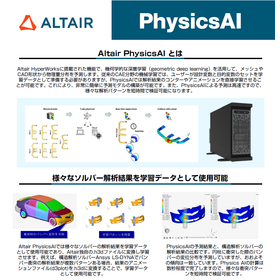Estimate electromagnetic waves from a distance using two different methods and compare the results! The shape was modeled in full.
The Yagi-Uda antenna is a directional antenna composed of a waveguide made up of multiple short elements and a long element reflector, along with a feed located in between. The electromagnetic waves radiated from the feed are analyzed using the finite element method, and based on the results, far-field plane waves are estimated. The feed radiates electromagnetic waves polarized in the Z-axis direction, and the behavior of the electromagnetic waves in the air region surrounding the entire antenna is analyzed using the finite element method. Next, based on those results, the far-field electromagnetic waves are estimated using two different methods, and the results are compared. The shape is modeled as a full model. [Software Used] ■PHOTO-WAVEjω *For more details, please refer to the related links or feel free to contact us.
Inquire About This Product
basic information
【Analysis Conditions】 ■Analysis Model - An antenna is installed within an air layer. - An "impedance boundary" is set at the outer perimeter of the air layer, establishing a "non-reflective boundary condition." - A model with "5 elements" is also included in the analysis for comparison of results. ■Radiated Electromagnetic Waves - Magnitude: 1 [V/m] in the Z-axis direction - Frequency: 1 G[Hz], wavelength λ = 3.0 × 10^-1 [m] ■Observation Points for Estimating Electromagnetic Waves in the Far Field: A circle with a radius of 1.0 [m] ■Method for Estimating the Far Field: Method using external field calculations and multipole expansion. *For more details, please refer to the related links or feel free to contact us.
Price range
Delivery Time
Applications/Examples of results
For more details, please refer to the related links or feel free to contact us.
Company information
At Photon, we are developing "electromagnetic field analysis software" that models and simulates products and components utilizing electromagnetic phenomena on a computer. In traditional design and development environments, the process has primarily revolved around trial and error through prototyping based on the experience of engineers and experiments with prototypes. However, conducting experiments using actual prototypes and analyzing the results requires significant time and cost. Moving forward, transitioning from an experimental and prototyping-based approach to an analysis-based design approach will be a crucial challenge for improving productivity, and establishing simulation technology as the core of analysis-based design techniques will be essential. In this context, Photon is developing and providing "analysis software" focusing on electromagnetic fields, as well as heat, vibration, and sound fields. By utilizing Photon's software, efficient development and design of various industrial products can be achieved. In this way, Photon aims to support users in reducing the number of prototypes, lowering development costs, and shortening development periods in their manufacturing environments, ultimately enhancing their competitiveness.





![[Analysis Case] The Effect of Magnetic Sheets for RFID Cards Using Outdoor Functionality](https://image.mono.ipros.com/public/product/image/062/2000060385/IPROS92180494480385262066.gif?w=280&h=280)





![SOLIDWORKS 2026 New Features Seminar [Free Participation]](https://image.mono.ipros.com/public/default/object/noimage_l.gif?w=280&h=280)